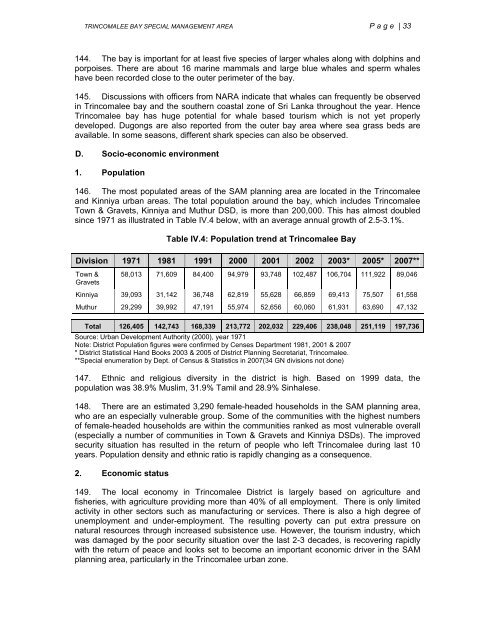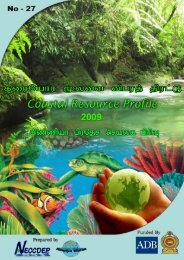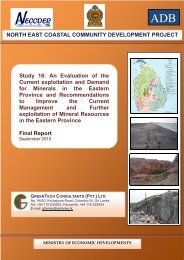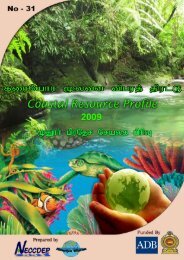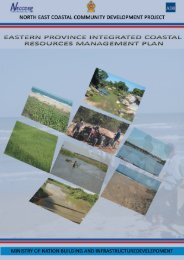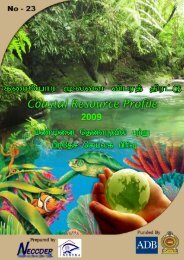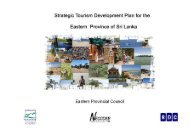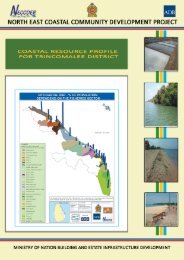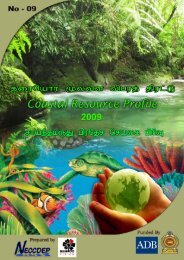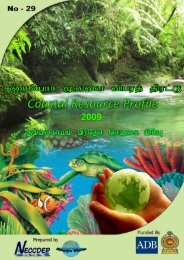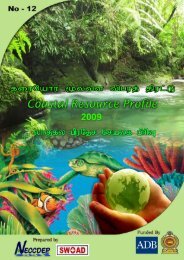Untitled - Neccdep.com
Untitled - Neccdep.com
Untitled - Neccdep.com
Create successful ePaper yourself
Turn your PDF publications into a flip-book with our unique Google optimized e-Paper software.
TRINCOMALEE BAY SPECIAL MANAGEMENT AREA Page | 33<br />
144. The bay is important for at least five species of larger whales along with dolphins and<br />
porpoises. There are about 16 marine mammals and large blue whales and sperm whales<br />
have been recorded close to the outer perimeter of the bay.<br />
145. Discussions with officers from NARA indicate that whales can frequently be observed<br />
in Trin<strong>com</strong>alee bay and the southern coastal zone of Sri Lanka throughout the year. Hence<br />
Trin<strong>com</strong>alee bay has huge potential for whale based tourism which is not yet properly<br />
developed. Dugongs are also reported from the outer bay area where sea grass beds are<br />
available. In some seasons, different shark species can also be observed.<br />
D. Socio-economic environment<br />
1. Population<br />
146. The most populated areas of the SAM planning area are located in the Trin<strong>com</strong>alee<br />
and Kinniya urban areas. The total population around the bay, which includes Trin<strong>com</strong>alee<br />
Town & Gravets, Kinniya and Muthur DSD, is more than 200,000. This has almost doubled<br />
since 1971 as illustrated in Table IV.4 below, with an average annual growth of 2.5-3.1%.<br />
Table IV.4: Population trend at Trin<strong>com</strong>alee Bay<br />
Division 1971 1981 1991 2000 2001 2002 2003* 2005* 2007**<br />
Town &<br />
Gravets<br />
58,013 71,609 84,400 94,979 93,748 102,487 106,704 111,922 89,046<br />
Kinniya 39,093 31,142 36,748 62,819 55,628 66,859 69,413 75,507 61,558<br />
Muthur 29,299 39,992 47,191 55,974 52,656 60,060 61,931 63,690 47,132<br />
Total 126,405 142,743 168,339 213,772 202,032 229,406 238,048 251,119 197,736<br />
Source: Urban Development Authority (2000), year 1971<br />
Note: District Population figures were confirmed by Censes Department 1981, 2001 & 2007<br />
* District Statistical Hand Books 2003 & 2005 of District Planning Secretariat, Trin<strong>com</strong>alee.<br />
**Special enumeration by Dept. of Census & Statistics in 2007(34 GN divisions not done)<br />
147. Ethnic and religious diversity in the district is high. Based on 1999 data, the<br />
population was 38.9% Muslim, 31.9% Tamil and 28.9% Sinhalese.<br />
148. There are an estimated 3,290 female-headed households in the SAM planning area,<br />
who are an especially vulnerable group. Some of the <strong>com</strong>munities with the highest numbers<br />
of female-headed households are within the <strong>com</strong>munities ranked as most vulnerable overall<br />
(especially a number of <strong>com</strong>munities in Town & Gravets and Kinniya DSDs). The improved<br />
security situation has resulted in the return of people who left Trin<strong>com</strong>alee during last 10<br />
years. Population density and ethnic ratio is rapidly changing as a consequence.<br />
2. Economic status<br />
149. The local economy in Trin<strong>com</strong>alee District is largely based on agriculture and<br />
fisheries, with agriculture providing more than 40% of all employment. There is only limited<br />
activity in other sectors such as manufacturing or services. There is also a high degree of<br />
unemployment and under-employment. The resulting poverty can put extra pressure on<br />
natural resources through increased subsistence use. However, the tourism industry, which<br />
was damaged by the poor security situation over the last 2-3 decades, is recovering rapidly<br />
with the return of peace and looks set to be<strong>com</strong>e an important economic driver in the SAM<br />
planning area, particularly in the Trin<strong>com</strong>alee urban zone.


